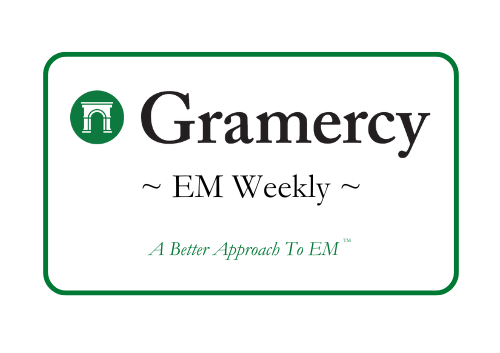Contents
Market Overview
Macro Update
Markets began the week with a semblance of stability, buoyed by President Donald Trump’s announcement of both temporary tariff exemptions for consumer electronics and extended timelines for auto companies to reassess supply chains. This equilibrium proved short-lived as limited progress in China-U.S. negotiations over tariff conditions emerged by mid-week. The tit-for-tat on trade continued, exemplified by the U.S. restricting Nvidia’s sale of chips to China. U.S. stock markets are ending the week in the red: S&P -1.7%, Nasdaq -2.4% and DJIA -2.4%.
Simultaneously, the Trump Administration initiated trade negotiations with Japan and engaged in a reportedly constructive dialogue with Mexico’s President Claudia Sheinbaum. The World Trade Organization adjusted its 2025 global trade volume forecast to a contraction of 0.2%, down from a previous estimate of 3.0%, highlighting the potential for a more severe downturn if proposed U.S. tariffs are reinstated. Global growth projections were also revised downward by 60bps, to 2.2%.
In the U.S., economic indicators presented a mixed picture. The New York Fed’s one-year inflation expectations surged to 3.58% in March from 3.13% in February, while manufacturing, services, and business outlook surveys indicated continued deterioration. Conversely, retail sales exceeded expectations with a 1.4% increase (vs. 1.2% consensus), and jobless claims declined. Housing starts, however, fell by a more-than-expected 11.5%, though this remains a volatile indicator. Large banks reported solid first-quarter earnings, largely driven by robust trading activities. Meanwhile, corporations are increasingly turning to scenario analysis for their outlooks – or withdrawing guidance amid prevailing uncertainties.
Federal Reserve Chair Jerome Powell dispelled the notion of a near-term Fed put and reiterated a “wait and see” approach. A “bad news” cut promoted by employment deterioration is not yet on his radar, while he brushed aside an “awful news” cut in response to market malfunction. Markets reacted by pushing stocks lower and strengthening U.S. Treasuries, possibly anticipating a policy shift by mid-year. President Trump expressed his discontent with Chair Powell’s lack of urgency, stating that “Powell’s termination cannot come fast enough.” Despite the reaction to Powell’s remarks, the 10-year Treasury note is ending the week close to 4.3%.
In Europe, the European Central Bank (ECB) implemented a 25bps rate cut, as anticipated, and signaled openness to further reductions. March inflation aligned with expectations at 2.2%, with the ECB assessing inflation as broadly “on track” to settle around its 2% target. Earlier in the week, UK inflation came in below consensus, influenced by subdued goods prices and a cooling in still-elevated services sector inflation.
In China, March export data remained robust despite the initial round of tariffs, while import growth disappointed. Credit growth accelerated, and retail sales, industrial production, and first-quarter GDP of 5.4% year-over-year surpassed estimates, likely reflecting previously announced economic support and front-loading of export orders ahead of potential tariff escalations.
Türkiye hiked its policy rate by 350bps, to 46%, despite consensus calls for a hold, underscoring the authorities’ commitment to combat inflation and contain the lira.
The initial round of Iran talks concluded with positive optics. However, inconsistencies in the U.S. position and President Trump’s impatience with the process surfaced later in the week. The next round of talks is scheduled for April 19th. Negotiations over the U.S.-Ukraine minerals deal continued, with the U.S. reportedly lowering the amount of aid it wants repaid, but Ukraine remaining unwilling to recognize past aid as debt.
China’s President Xi Jinping completed his first foreign trip of the year to the Association of Southeast Asian Nations bloc, reflecting the balancing act countries in the region must have amid escalating U.S.-China tensions.
In Latin America, Ecuador’s President Daniel Noboa secured re-election, leading to a significant rally in bond prices. In Argentina, President Javier Milei and Minister of Economy Luis Caputo announced the next phase of the country’s policy agenda, anchored by a new IMF facility and a $12 billion upfront disbursement from the fund.
EM Credit Update
EM hard currency sovereign debt posted a strong week, returning 1.9%, supported by a relatively calmer global risk environment. The high yield segment led performance with a 2.6% return, significantly outpacing the 1.2% return from investment grade sovereigns. Sovereign spreads narrowed by 12bps overall, driven by a 31bps tightening in high yield, while investment grade spreads were broadly stable.
Ecuador stood out as the top performer, rallying 29.9% as markets responded positively to President Noboa’s re-election and policy continuity. In contrast, Bolivia underperformed, losing 1.5% amid growing concerns over foreign exchange pressures and the use of capital controls, both weighing on investor confidence.
EM corporates lagged sovereigns this week, delivering a more modest 0.9% return. The performance was relatively uniform across credit quality, but spreads widened by 8bps.
EM local currency sovereigns returned 1.0%, supported by a broad-based foreign exchange recovery and continued softness in the U.S. dollar. South Africa and Mexico led gains, benefiting from renewed foreign inflows and improved macro sentiment. Türkiye, however, underperformed with a 1.2% loss.
Primary market activity resumed this week with Colombia issuing $3.8 billion and 13 corporate issuers tapping the market.
The Week Ahead
All eyes will be on Washington next week as the IMF publishes its latest World Economic Outlook alongside the Spring Meetings, where investors, policymakers, and economists will convene against a backdrop of heightened geopolitical and economic uncertainty.
In the U.S., attention will remain divided between corporate earnings and a series of key economic data releases, including regional Fed surveys from Richmond and Kansas City, S&P Global Manufacturing PMIs, new home sales, and the University of Michigan consumer sentiment index.
In the eurozone, the focus will be on flash PMI data and consumer confidence, with particular interest in the German IFO business climate survey as markets assess the potential impact of ongoing trade tensions and tariff uncertainty on the bloc’s largest economy.
The UK will release retail sales and PMI data, which will be closely scrutinized for signs of how domestic consumption and business activity are evolving.
In Asia, attention will turn to monetary policy decisions from the People’s Bank of China and Bank Indonesia.
Fixed Income
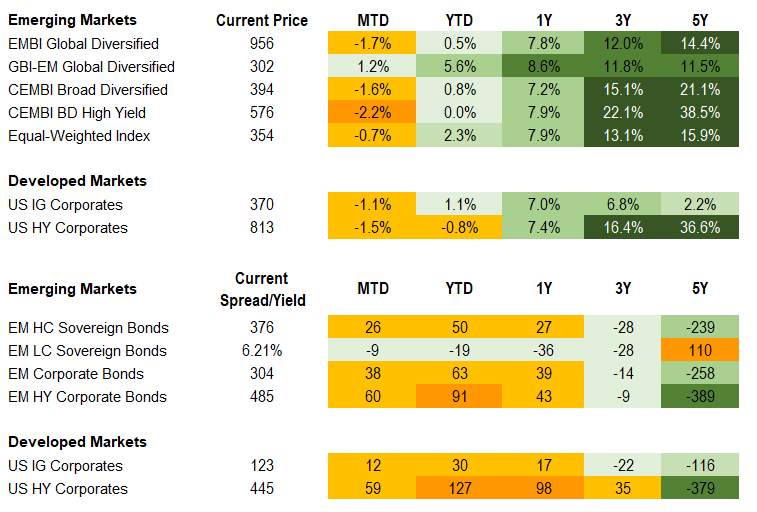
Equities
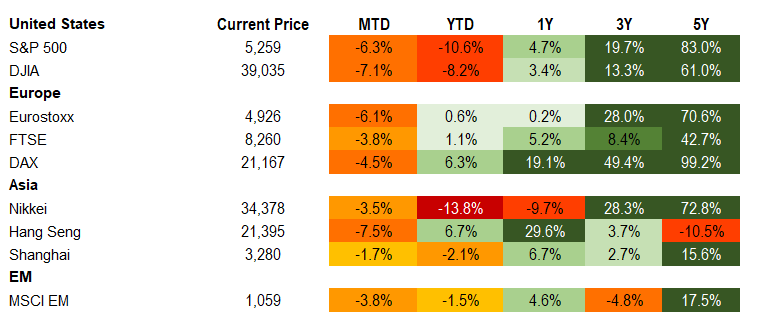
Commodities

Source for data tables: Bloomberg, JPMorgan, Gramercy. EM Fixed Income is represented by the following JPMorgan Indicies: EMBI Global, GBI-EM Global Diversified, CEMBI Broad Diversified and CEMBI Broad High Yield. DM Fixed Income is represented by the JPMorgan JULI Total Return Index and Domestic High Yield Index. Fixed Income, Equity and Commodity data is as of April 17, 2025 (mid-day).
Country Highlights
Noboa Re-elected President of Ecuador in a Landslide
Event: Ecuador’s incumbent, center-right President Noboa, won the presidential election run-off on Sunday, April 13th, against leftist challenger Luisa Gonzalez, in a 56% vs. 44% landslide.
Gramercy Comment: Noboa’s victory margin was significantly wider than suggested by the extremely tight first round outcome, which resulted in a less than 20,000 vote difference between Noboa and Gonzalez, and the latest polls. The market entered the second round with an overly bearish bias having almost fully priced a victory for Ms. Gonzalez, a close ally of populist former President Rafael Correa. As such, President Noboa’s victory catalyzed a massive rally in Ecuador’s sovereign bonds, propelling them to best performers across emerging markets year-to-date. With a strong mandate after his compelling win and a large voting bloc in the National Assembly, we expect the market-friendly momentum by the Noboa Administration to continue, and also to support the bond complex in coming months. Furthermore, we expect excellent relations with the IMF and the Trump Administration, as well as a weaker USD, to offset the negative impact of lower oil prices for Ecuador’s dollarized economy and fiscal health.
Argentina Embarks on Next Phase of Macro Agenda
Event: Argentina presented the next phase of its economic agenda late last week, which was followed by an announcement from the IMF on board approval of country’s new $20 billion Exchange Funded Facility (EFF), of which $12 billion was disbursed upfront.
The foreign exchange regime has now moved to a managed float within a band of USD/ARS 1,000-1,400, to crawl at 1% month-over-month with discretion to intervene outside of the band. The blend scheme for exporters and restrictions on individuals and distribution of profits to shareholders abroad have been eliminated, while the Central Bank plans to issue more Bopreales to address foreign exchange stocks. Authorities will also target tight monetary policy. The IMF expects net foreign exchange reserves to rise by $4 billion in 2025, excluding IMF disbursements, and assuming the country regains access to markets next year. Bonds rallied toward previous highs on the news.
Gramercy Comment: The larger than expected front-loading, and greater loosening of foreign exchange policy in the context of a fiscal anchor, bodes well for short-term external dynamics despite the uncertain backdrop. This is an important step towards credit normalization, regaining market access, and achieving more sustainable economic growth. Markets will watch for reserve accumulation trends in the coming months, the first program review set for June, inflation, provincial votes and polls into the mid-terms.
Emerging Markets Technicals
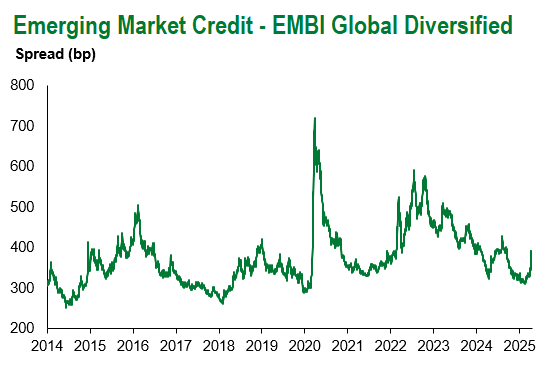
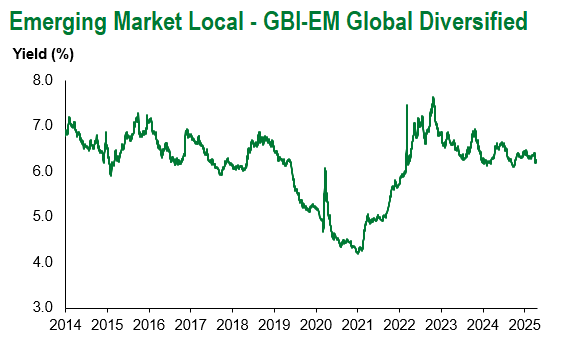
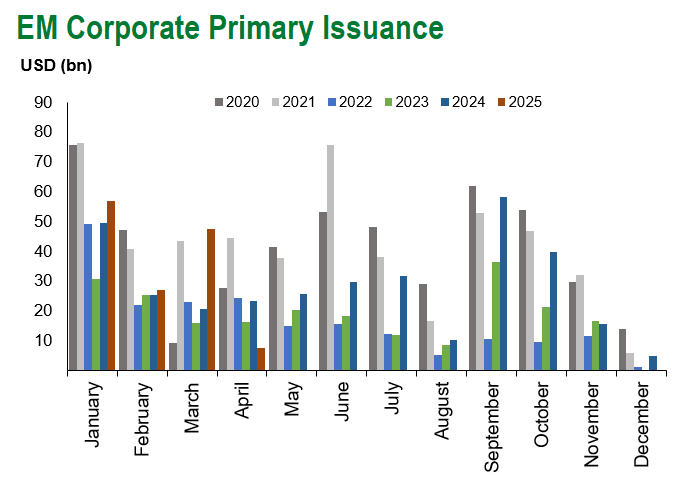
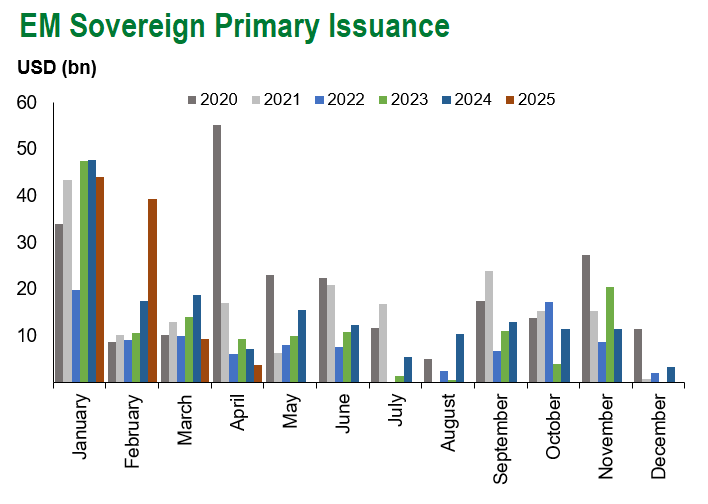
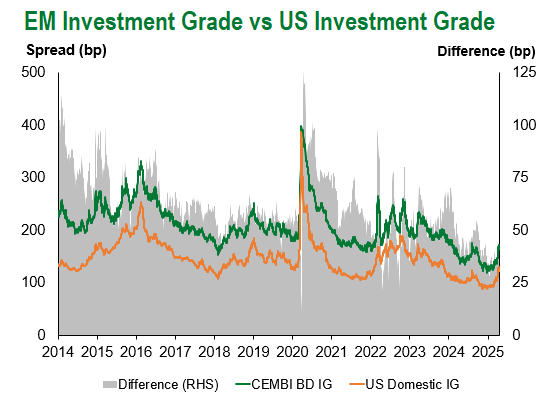
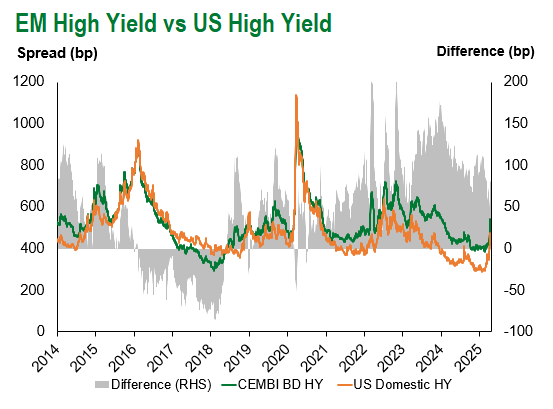
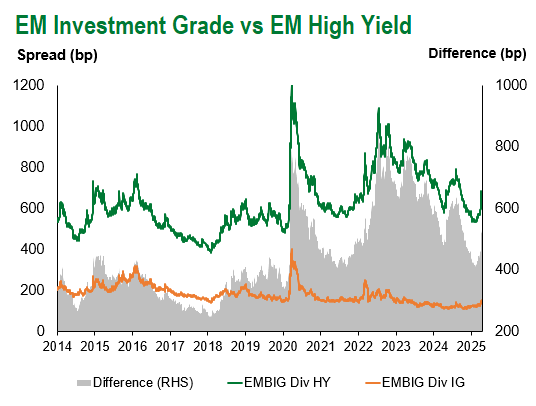
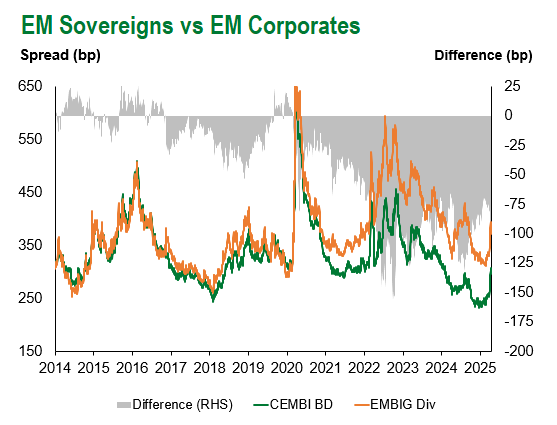
Emerging Markets Flows
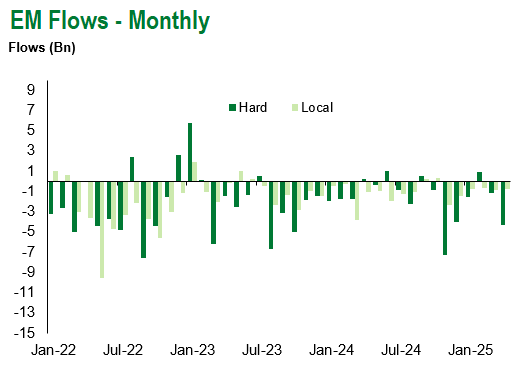
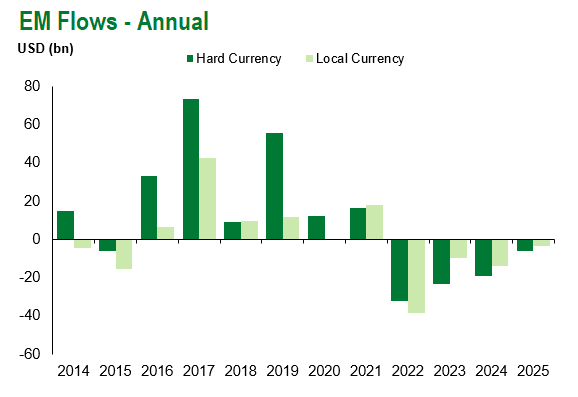
Source for graphs: Bloomberg, JPMorgan, Gramercy. As of April 17, 2025.
For questions, please contact:
Kathryn Exum, CFA ESG, Director, Co-Head of Sovereign Research, [email protected]
Petar Atanasov, Director, Co-Head of Sovereign Research, [email protected]
This document is for informational purposes only. The information presented is not intended to be relied upon as a forecast, research or investment advice, and is not a recommendation, offer or solicitation to buy or sell any securities or to adopt any investment strategy. Gramercy may have current investment positions in the securities or sovereigns mentioned above. The information and opinions contained in this paper are as of the date of initial publication, derived from proprietary and nonproprietary sources deemed by Gramercy to be reliable, are not necessarily all-inclusive and are not guaranteed as to accuracy. This paper may contain “forward-looking” information that is not purely historical in nature. Such information may include, among other things, projections and forecasts. There is no guarantee that any forecasts made will come to pass. Reliance upon information in this paper is at the sole discretion of the reader. You should not rely on this presentation as the basis upon which to make an investment decision. Investment involves risk. There can be no assurance that investment objectives will be achieved. Investors must be prepared to bear the risk of a total loss of their investment. These risks are often heightened for investments in emerging/developing markets or smaller capital markets. International investing involves risks, including risks related to foreign currency, limited liquidity, less government regulation, and the possibility of substantial volatility due to adverse political, economic or other developments. References to any indices are for informational and general comparative purposes only. The performance data of various indices mentioned in this update are updated and released on a periodic basis before finalization. The performance data of various indices presented herein was current as of the date of the presentation. Please refer to data returns of the separate indices if you desire additional or updated information. Indices are unmanaged, and their performance results do not reflect the impact of fees, expenses, or taxes that may be incurred through an investment with Gramercy. Returns for indices assume dividend reinvestment. An investment cannot be made directly in an index. Accordingly, comparing results shown to those of such indices may be of limited use. The information provided herein is neither tax nor legal advice. Investors should speak to their tax professional for specific information regarding their tax situation.
